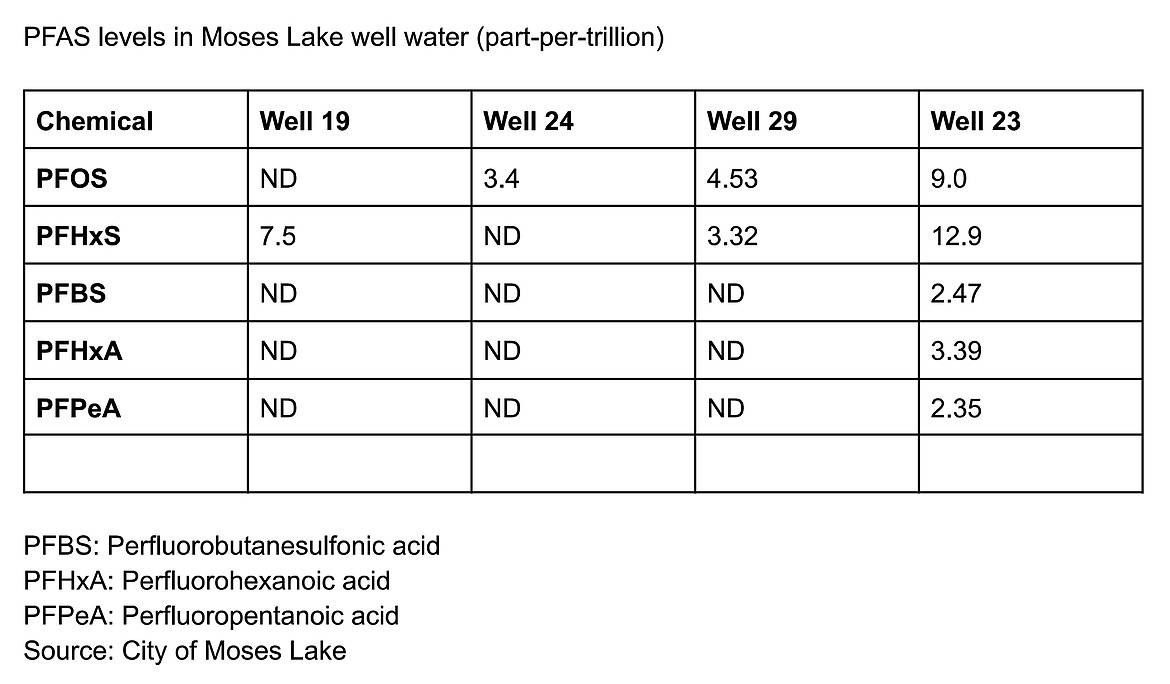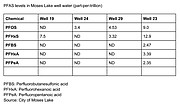Moses Lake says ‘forever chemicals’ found in 4 city wells
MOSES LAKE — The City of Moses Lake has stopped pumping water from three of its municipal drinking water wells following the discovery of per- and polyfluoroalkyl substances – known as PFAS chemicals – above Environmental Protection Agency standards that have been proposed but are not yet in place, according to Water Services Manager Chad Strevy.
Strevy said the chemicals have been detected in four of the city’s 18 wells – three of them north of SR 17 on what used to be Larson Air Force Base and the fourth west of the lake itself in Mae Valley, not far from the Links at Moses Pointe.
“We sampled in March,” Strevy said, adding that one well was tested in April.
PFAS chemicals are based on long chains of fluorine atoms bonded to groups of carbon and hydrogen atoms and have been widely used in the creation of nonstick surfaces, water-resistant fabrics and firefighting foams. Because PFAS substances do not break down naturally, some call them “forever chemicals,” and researchers have linked the chemicals to high risks of certain kinds of cancer, according to information available from the Washington State Department of Health.
The EPA’s current standards for two significant PFAS chemicals – perfluorooctanoic acid, or PFOA, and perfluorobutane sulfonic acid, or PFOS – are 70 parts per trillion. However, the EPA has proposed reducing that to 4 parts per trillion, and while that rule likely will not come into effect until early 2024, Stevy said that as water manager he did not want to approve water from wells where PFOS and/or PFAS were detected at levels higher than the proposed new standard.
“We got ahead of it,” Strevy said. “Unless major comments or science comes forward determining that the 4 parts per trillion is not rational. But that’s highly unlikely.”
PFOS levels above or near the 4 parts-per-trillion proposed limit were found in three wells – 3.4 ppt in well 24, 4.53 ppt in well 29, and 9.0 ppt in well 23 – while levels near or above the proposed limit of a related PFAS chemical, perfluorohexanesulfonic acid, or PFHxS, were also found in three wells – 7.5 ppt in Well 19, which is located in Mae Valley, 3.32 ppt in Well 29 and 12.9 ppt in Well 23. City wells 23, 24 and 29 are all located on what used to be Larson Air Force Base, which is now the Larson community and the Port of Moses Lake.
“I don’t think Larson is uncommon, is different from any other Air Force base,” said Public Works Superintendent Tony Massa.
Moses Lake is the most recent Washington city to discover PFAS chemicals in its water, according to a statement released by the city Tuesday morning, joining localities as varied as Airway Heights, Bremerton, Grays Harbor County and Yakima County.
The Port of Moses Lake is also the location of an EPA superfund site focused on the removal of trichloroethane, or TCE, chemicals, used primarily by the Air Force as solvents to clean aircraft and machinery, which the Air Force simply allowed to run off in the 1950s and 1960s. Strevy said the detection of the PFAS chemicals follows the general plume of TCE in the groundwater south and west of the former airbase. However, while the EPA has a number of monitoring wells in the area southwest of Larson and reports it has detected levels of PFAS chemicals in groundwater it has tested, the agency’s detection and remediation efforts are focused on TCEs.
“That could change,” Strevy added. “Obviously, we hope it will change.”
Strevy said that given the way the city’s wells are constructed, he’s not sure what the source of the PFAS chemicals is or how they are getting into the water. The four wells in question are drilled down about 1,000 feet below the surface into the Grande Ronde aquifer, large lakes of underground water amid basalt estimated to be anywhere from 10,000 to 24,000 years old, and the wells are lined with concrete all the way down to the aquifer, he said.
“We just don’t know. We’ve tested the wells, and the next is OK, let’s look at potential sources,” he said.
Right now, Strevy said, the city is keeping Well 24, which is currently under the proposed EPA limit for PFOS, in reserve and using water from that well to help meet demand as an early heat arrives over the Columbia Basin. To use the wells, Strevy said the city will need either to blend the water or to filter it in order to get the level down below 4 parts per trillion.
“It was hot yesterday, and it’s only going to get hotter in the summertime,” he said. “We’re going to wait as long as we can, and then we’ll eventually have to turn (Well) 29 on also. Unless we can get some conservation.”
Strevy estimates the cost of installing filter systems for each well at around $3 million, though Massa noted that Well 23, in which a host of related PFAS chemicals were found in addition to PFOS and PFHxS, would require additional kinds of treatment.
“And that’s in yesterday’s dollars,” Massa added.
“It’s not built in a month,” Strevy added. “We would have to do a pilot study to get the right treatment in, and then you’re talking probably 18 months minimum for a study and construction.”
Charles H. Featherstone can be reached at cfeatherstone@columbiabasinherald.com





